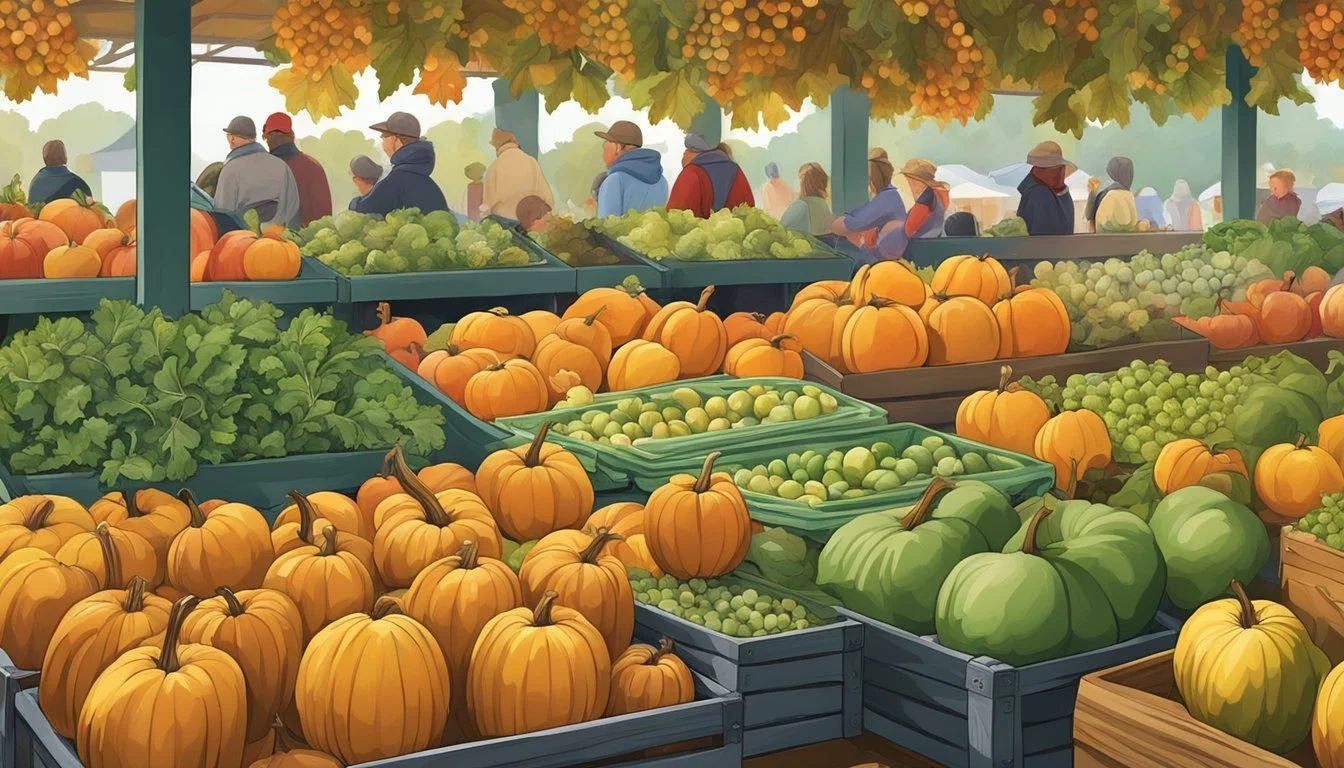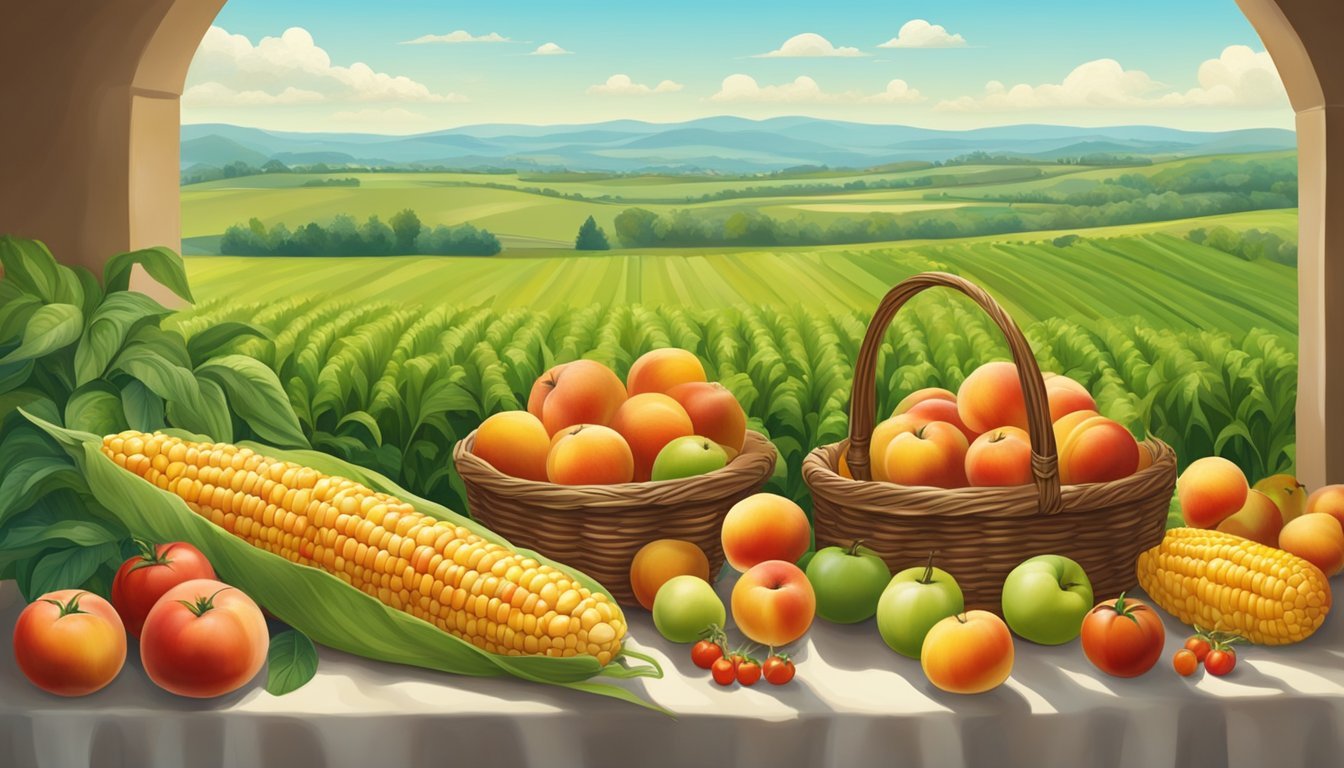Delaware Seasonal Fruit & Vegetables in September
Your Guide to Fresh Produce
This Article is Part of our Delaware Seasonal Fruit & Veg Calendar
In September, Delaware's agricultural landscape transforms as a variety of fruits and vegetables reach the peak of ripeness. This period marks an ideal time for consumers to enjoy some of the freshest, most flavorful produce the region has to offer. Local markets and farm stands become abundant with seasonal offerings that not only support the state's farming community but also provide an opportunity for consumers to incorporate fresh and nutritious ingredients into their meals.
The assortment of produce available in Delaware during this month is diverse, with each item embodying the essence of the fall harvest. Seasonal fruits such as apples are highly anticipated, with their crisp texture and sweet flavors making them a favorite for both raw and cooked dishes. Vegetables like Brussels sprouts and cabbage offer robust flavors and are often used in hearty recipes that complement the cooler weather.
With a focus on freshness and nutritional value, September's seasonal produce in Delaware encourages a connection between consumers and their food sources. The turn of the season serves as a reminder of the rich agricultural tapestry of the area and the benefits of eating in tune with nature's cycles. Enthusiasts of wholesome, farm-to-table eating find September an exceptionally rewarding time to explore Delaware's seasonal offerings.
Optimal Seasonality and Selection
In September, Delaware's harvest calendar is rich with a diverse range of seasonal produce. Consumers can enjoy peak freshness and flavors, including the crisp textured apples and juicy pears. Vegetables like squash and pumpkins also start to become abundant, offering a sweet and earthy taste profile.
Fruits:
Apples: Look for a firm feel and vibrant color. Varieties available may range from tart to sweet, perfect for baking or snacking.
Pears: Choose pears that are slightly soft at the stem end, indicating ripeness without being overripe.
Vegetables:
Squash: Varieties such as butternut or acorn should have a hard, tough rind and deep-colored skin.
Pumpkins: Select pumpkins that are fully colored and have a hard rind, ensuring matured flavor.
For consumers seeking to incorporate local produce into their diets, Delaware's September offerings provide nutritive value and enhanced taste due to the produce being at its peak. It is worth noting that tasting samples at local markets can guide buyers in choosing produce that aligns with their flavor preferences, whether that's a preference for something more tart or sweet.
Shoppers should remember that not all produce will be available across the entirety of Delaware due to microclimates and specific regional growing conditions. However, with the right selection, one can enjoy the full palate of September's seasonal offerings.
September Fruits in Delaware
In Delaware, September ushers in a prominent harvest of apples, the tail end of the berry season, and the last of the stone fruit offerings.
Apple Varieties
Delaware's apple selection peaks in September, featuring an array of apple varieties such as Gala, Honeycrisp, and Red Delicious. They are known for their crisp texture and varying flavors that range from sweet to tart. Local orchards offer apple-picking experiences, allowing visitors to select their fresh fruit directly from the tree.
Gala Apples: Sweet, ideal for snacking.
Honeycrisp Apples: Crisp and juicy, perfect for salads.
Red Delicious: Mildly sweet, commonly used for fresh eating.
End of Berry Season
September in Delaware marks the closing of the berry season. Late-ripening species like raspberries and blackberries (how long do blackberries last?) provide one last bounty. These berries are enjoyed for their rich flavor and are often used in jams, jellies, and desserts.
Raspberries: Sweet with a slight tang.
Blackberries: Deep flavor, good for preserves.
Stone Fruits
Stone fruits such as peaches and late-season nectarines are finishing their cycle by early fall in Delaware. These fruits are best consumed fresh due to their succulence and are also excellent in baked goods.
Peaches: Juicy and sweet with a velvety skin.
Nectarines: Similar to peaches but with smooth skin.
September Vegetables in Delaware
September marks the transition from summer to fall, bringing a shift in crop availability in Delaware. This is a peak time for harvesting a variety of vegetables that thrive in the state's climate.
Leafy Greens Harvest
In Delaware, September is an ideal time for harvesting leafy greens. Gardeners can typically gather a bounty of spinach, kale, and lettuces. These greens, known for their short maturation period, are perfect for a late-summer sowing and early fall harvest.
Spinach: Rich in iron and vitamins, spinach enjoys the cooler days of early fall.
Kale: Hardy and nutritious, kale can even withstand frost, making it an excellent crop for extending the season.
Lettuces: A range of lettuce types reach maturity during this month, offering crisp leaves for autumn salads.
Root Vegetables
A variety of root vegetables are ready for digging up in the cooler soil of September. Carrots and beets, for example, attain a sweet and concentrated flavor due to the cool nighttime temperatures.
Carrots: Often sweeter after the first frost, carrots can be harvested throughout September.
Beets: These earthy vegetables reach their prime in both flavor and texture during this month.
Nightshades
September also sees the tail end of the nightshade vegetable harvest, such as tomatoes and eggplants. (What wine goes well with eggplant?) While the window for harvest is closing, the crops that remain are typically robust in flavor.
Tomatoes: Heirloom and other late-maturing tomatoes are at their juiciest.
Eggplant: Generally harvested through the end of September, eggplants offer a final burst of summer flavor.
The month's cooler weather also contributes to the final harvest of other nightshades, like peppers. Gardeners often have success with a range of varieties including bell peppers and hot peppers.
Peppers: From sweet bells to spicy varieties, peppers can continue to be picked until the first frost.
Local Agricultural Activities
September in Delaware is ripe with activities for those interested in experiencing local agriculture first-hand. From picking fresh produce to engaging in festive seasonal events, there is a variety of ways for visitors and community members to dive into the agricultural world.
U-Pick Farms
U-Pick Farms in Delaware offer an abundance of fresh produce that visitors can pick themselves. In September, apple varieties are in prime picking condition. Numerous farms provide visitors the opportunity to roam among rows of trees heavy with fruit, offering a hands-on approach to harvesting their own food. Additionally, pumpkin patches begin to open, allowing individuals to select the perfect pumpkin for carving or cooking.
Top Picks for September:
Apples: Assorted varieties
Pumpkins: Various sizes and types
U-Pick Farms also typically include other family-friendly activities such as corn mazes which are especially popular during the fall season.
Agritourism Events
Delaware's Agritourism Events celebrate the state's rich agricultural heritage and bring communities together. Events in September cater to the harvest season, showcasing local farmers' markets brimming with seasonal vegetables like sweet corn, and squashes. These gatherings often feature hayrides, garden tours, and educational exhibits that promote a deeper understanding of food origins.
Featured September Events:
Harvest festivals
Corn maze adventures
Educational farm tours
Beyond typical produce harvests, some Delaware farms may begin preparing for the upcoming Christmas season, with activities such as planning tree layouts for their Christmas tree farms, although tree picking will not start until later in the year. Through U-Pick Farms and Agritourism Events, September offers a direct connection to Delaware's agricultural roots, with ample opportunity for enjoyment and education.
Health Benefits of Seasonal Eating
Eating fruits and vegetables in their peak season has numerous health benefits. Seasonal produce is more likely to be fresher and nutritionally complete, as it has been harvested at the optimal time. Here's how seasonal eating in Delaware during September supports a healthy lifestyle:
Diversity of Nutrients: Seasonal fruits and vegetables provide a wider variety of nutrients. Eating an assortment of seasonal produce ensures a diet rich in essential vitamins and minerals.
Enhanced Flavor and Freshness: Produce that is in season has had the proper time to grow and ripen, which enhances its flavor and freshness. This may encourage more consumption of healthy, raw fruits and vegetables, boosting one's intake of fiber, vitamins, and antioxidants.
Support for Local Agriculture: Choosing local, seasonal items supports the regional economy and the environment. This also means the food has traveled shorter distances, potentially reducing its carbon footprint.
Month Fruits Vegetables September Apples, Pears Zucchini, Spinach
By incorporating local seasonal produce into their diet, individuals are not only consuming foods at their nutritional peak, but also supporting the sustainability of their community. Consuming seasonal, local produce underscores the importance of a food's journey from farm to table and highlights the role of agriculture in fostering a healthy community.
Preserving the Harvest
Preserving the fruits and vegetables of September in Delaware ensures that one can enjoy the flavors of the harvest year-round. Methods like canning, freezing, and drying are excellent for extending the shelf life of fresh produce.
Home Canning Techniques
Home canning is a popular method for preserving fruits and vegetables. It involves sealing food in jars at high temperatures, to prevent spoilage. There are two primary canning methods:
Water Bath Canning: Ideal for high-acid foods like tomatoes, pickles, and fruits.
Sterilize canning jars and lids.
Fill jars with produce, leaving some headspace.
Seal with lids and immerse in boiling water for a set time.
Remove jars to cool and check seals.
Pressure Canning: Necessary for low-acid foods such as vegetables and meats.
Fill sterilized jars with produce, maintaining headspace.
Seal jars and place in pressure canner.
Process at the specified pressure for the recommended time.
Allow canner to cool before removing jars.
Freezing and Drying Methods
Freezing and drying are straightforward methods of preserving a variety of fruits and vegetables available in September, like apples and bell peppers.
Freezing:
Select fresh, ripe produce and wash thoroughly.
Blanch vegetables to preserve color and texture.
Slice or chop if needed, then arrange in a single layer on a baking sheet to freeze.
Once frozen, transfer to airtight containers or bags.
Drying: Dehydrating food by removing moisture inhibits the growth of bacteria, yeasts, and mold.
Wash and prepare produce, cutting into even, thin slices.
Arrange on drying trays, ensuring pieces do not overlap.
Use a food dehydrator or an oven set at a low temperature, checking periodically until completely dried.
Store in a cool, dark place in airtight containers.
Impact on Local Economy
The economic implications of Delaware's seasonal fruit and vegetable market in September resonate at multiple levels. State-level records indicate economic growth reflected in the surge of farmers' market sales, which achieved a noteworthy milestone by recording $4.14 million in 2023, an increase from the previous year.
At the local level, this rise in farmers' market sales mirrors a strengthened economic ecosystem within cities and communities. These markets contribute to the local economy by not only providing income to farmers but also by creating jobs and supporting ancillary businesses such as packaging, transport, and marketing.
The following highlights the economic impact:
Direct Economic Contributions: Money spent on local produce stays largely within the community, fostering financial stability among farmers and circulating funds within the local economy.
Indirect Economic Benefits: Local purchases support the logistics networks, including transportation and distribution, reinforcing business for local suppliers.
Delaware's economic landscape benefits from these dynamics, making the state an example of how embracing seasonal produce can stimulate local and state economic progress. This approach enhances city economies, promoting growth through a focus that prioritizes seasonal agricultural output. The upward trend in consumer demand for locally-grown produce solidifies this strategy as not only sustainable but also profitable for the state's agricultural sector.
Recipes and Preparation Tips
Delaware's September harvest offers a bountiful selection of fruits and vegetables that are ideal for a range of recipes. From tender greens to robust root vegetables, the possibilities for creating fresh and cooked dishes are extensive, leveraging both the natural flavors and nutritional benefits.
Salads and Raw Dishes
One can showcase the crisp, golden hues of September with an array of salads and raw preparations. Beetroot, with its earthy sweetness, pairs well with pink radishes and tender lettuce to create visually appealing and nutrient-dense salads. Delawareans might enjoy combining thinly sliced raw beetroot and radishes with mixed greens, dressed simply with a vinaigrette to enhance their fresh flavors. Here is a simple list of ingredients one might consider for a vibrant September salad:
Mixed tender lettuce
Sliced golden beetroot
Thinly cut pink radishes
A simple dressing of olive oil, lemon juice, salt, and pepper
Cooking and Baking
When it comes to cooking and baking, seasonal produce can transform from raw to comfort food that warms the soul. Butternut squash (how long does butternut squash last?), with its sweet, nutty flavor, shines when roasted or turned into a creamy soup. For baking, one might consider incorporating apples in a variety of dishes. Here's a brief cooking guide focused on seasonal ingredients:
Roasting: Golden butternut squash cubes tossed in olive oil and roasted at 400°F until tender add a caramelized touch to any meal.
Baking: Pink-skinned apples, cored and filled with a mix of oats, cinnamon, and brown sugar, bake into a delightful dessert when cooked at 350°F until the apples are tender.
By using these techniques, cooks can capitalize on the texture and flavors of Delaware's September produce, whether it’s savoring the freshness of salads or enjoying the heartiness of cooked dishes.
Seasonal Eating and Sustainability
Eating seasonally is a sustainable choice that can have a significant positive impact on the environment. In Delaware, September brings an array of fruits and vegetables that are at their peak, which not only supports local farms but also reduces the environmental footprint associated with long-distance transportation.
Choosing local produce reduces greenhouse gas emissions since food travels a much shorter distance from farm to plate. For instance, selecting apples from nearby orchards instead of those shipped from across the country conservatively saves on fossil fuels.
Local Farms benefit from seasonal eating as it helps in maintaining a balanced ecosystem. They often use crop rotation and other sustainable farming practices that contribute to soil health and biodiversity. In contrast, industrial farming operates on a mass scale, often at the expense of environmental health. By supporting smaller, local farms, consumers can aid in preserving the local landscape and farming community.
Here is a list of some produce typically in season in Delaware during September:
Fruits:
Apples
Pears
Vegetables:
Broccoli
Kale
Tomatoes
Moreover, sustainable eating includes considering the Environmental Impact of produce. Seasonal fruits and vegetables require fewer artificial interventions, such as refrigeration and hot houses, than out-of-season counterparts. This results in lower overall energy consumption.
By integrating these seasonally available foods into their diets, Delawareans not only enjoy fresher, tastier produce but also contribute to a more sustainable and environmentally friendly food system.
Connect with Delaware's Produce Community
Delaware's produce community thrives through active engagement on multiple platforms, notably on social media. Farmers, consumers, and enthusiasts can connect over their shared love for fresh, local produce.
Facebook and Twitter serve as key spaces for interaction. Producers frequently update their profiles with the latest harvest information, seasonal recipes, and event announcements. These platforms facilitate real-time communication, allowing the community to stay informed about what produce is currently in season. It's common to find pages or groups dedicated to Delaware produce where members can share tips, experiences, and even coordinate visits to local farms.
Involvement in the local food scene extends beyond digital spaces. The community encourages participation in local farmers' markets and events celebrating the seasonal bounty. Through these gatherings, consumers have the opportunity to meet growers, ask questions, and provide direct support for sustainable practices.
For those looking to delve deeper, many Delaware farms and agricultural businesses offer newsletters. Subscribers receive updates about available produce, volunteer opportunities, and educational resources, fostering a more personal connection to the food they eat.
To encourage ongoing community engagement, consider following these steps:
Join Local Produce Groups on Facebook.
Follow Delaware farms and food initiatives on Twitter.
Sign Up for newsletters from your favorite local farms.
Participate in community events related to agriculture and seasonal produce.
By engaging through these avenues, individuals contribute to the sustainability and vibrancy of Delaware's agriculture.








